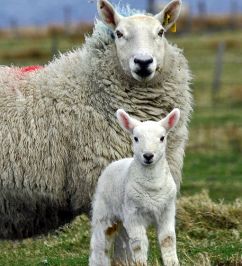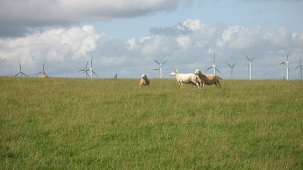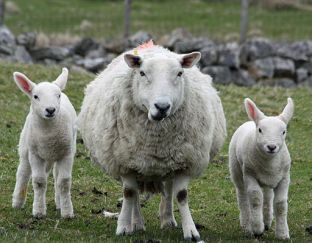Cheviot: a Spring Sheep
The sheep that look like bunnies!

Cheviot is one of the well-recognized breeds in England recorded to be on the borderlands as early as 1372. The story is that the breed developed from sheep that swam ashore from a shipwrecked Spanish ship after the defeat of the Armada. Developed on the Scottish Border and Northumberland, and named for the Cheviot Hills, many authors have commented on the “Border Sheep” or the “Border Cheviot Sheep”. They were for acclaimed for the resilient “River or Border Tweed” that was made strictly of Cheviot whose helical crimp structure allows for greater fiber durability.
Border Cheviots are the charming little sheep that bring to mind spring. There are 4 different subgroups Border Cheviots or Cheviots, American Miniatures, North Country- found mostly in Canada, and Brecknock Hill found in Wales. They are all white sheep with clean
faces and legs lacking wool. Developed as a dual breed range sheep on the borderland hills, they are a hardy, very alert and active sheep. Their ears are perked giving them a look of being “awake.” The faces are clean with roman noses, dark eyes rimed with dark skin and little black noses to protect against skin cancer. They have hard black feet that are good for marsh lands and wet conditions, and rocky ground. Cheviots are high producers of wool as they have quality fleeces into their teens – amazing when you consider the average life expectancies of sheep is 12.
The Fiber: Cheviots Interesting Crimp

All wool has some crimp even if it is not visible to the human eye. Wool fibers grow in a wavy form with a certain amount of twist generally known as crimp. It is the amount of twist with the wave that affects the different outcomes of the crimp. How keratin, one of the key elements in the structure of wool, connects and is affected by the sheep’s biology, dictates the crimp and how it “grows.” Keratin connects in two basic ways: folded chain characteristics (think accordion) and helical (spiral staircase).
Helical crimp is super resilience, with a structural integrity as the surfaces adjust and shift to prevent wear. Furthermore the flexibility afforded by the helix helps to prevent fracturing or breakage under pressure. Helical crimp helps makes the fibers feel springy.
Cheviot fiber is often classified with down breeds because of 3 dimensional crimp giving it a similar chalky appearance. The fiber dyes clearly taking colors at their purist point with but without the brilliance of the longwools .

Fleeces are dense and firm but springy to the touch, with no kemp or colored hair. Cheviot fleeces are generally 5-10 lbs with 50-65% yield. They have a 4-5 inch staple on average but some subgroups can be longer. The micron count is 27- 33 with softer fleeces from the miniatures of the breed. Locks are rectangular staples with slightly pointed tips the crimp is bold and uniform.
When processing hand cards work best and longer fleeces can be flicked or combed.
Cheviot is not considered a luxury fiber; however, it makes outstandingly durable items. Felters can use Cheviot as an alternative white for large projects or as base to build from as it both wet and needle felts. It is great for sweaters, socks and everyday high were garments or for everyday household goods such as blankets and pillows that might take a lot of use and abuse.
This is an awesome fiber for beginners to veteran spinner, it is a pleasure to spin, and you won’t find yourself fighting your fiber as you draft. Cheviot has a lovely draft when combed but keep in mind that when plied it can be loftier than you expect. With the crimp pattern, the fibers have air caught in the yarn giving you spring and a yarn that feels light and keeps warmth. Don’t over spin or you will lose some of the basic elements of the yarn and its softness. Depending on how you spin the fibers will bloom a little but what your plied yarn looks like will be similar to your finished piece
I got to spin some samples of the Ashland Bay Cheviot and it is a picnic to spin, it has a smooth draft with a lovely texture that makes me want to keep filling bobbins. I was spinning for sock yarn that I will dye for both the colors and the durability as I am hard on socks.
If you have any questions feel free leave it in the comments… and Happy Easter!
